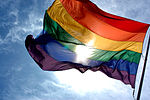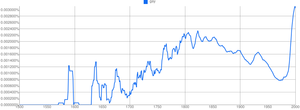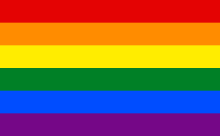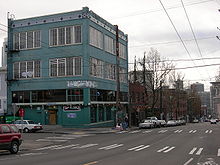- Gay
-
This article is about gay as a term. For homosexuality, see Homosexuality. For other uses, see Gay (disambiguation).
Part of a series on
Lesbian, gay, bisexual, transgender (LGBT) peopleSexual orientation Homosexuality · Demographics
Biology · EnvironmentHistory LGBT history · Timeline
Social movementsCulture LGBT community · Coming out
Pride · Slang · Symbols
Gay villageRights Laws around the world
Marriage · Union · Adoption
Military service
Legal aspects of transsexualismSocial attitudes Heteronormativity
LGBT stereotypes
Religion and homosexuality
Religion and transgenderPrejudice · Violence Heterosexism · Homophobia
Lesbophobia · Biphobia
Monosexism · Transphobia
Violence against LGBT peopleAcademic fields and
discourseLGBT/Queer studies
Lesbian feminism
Queer theory · Transfeminism
Lavender linguistics LGBT portal
LGBT portalGay is a word (a noun or an adjective) that refers to a homosexual person, especially a homosexual male. For homosexual women the specific term is "lesbian".
The term was originally used to refer to feelings of being "carefree", "happy", or "bright and showy"; it had also come to acquire some connotations of "immorality" as early as 1637.[1] The term's use as a reference to homosexuality may date as early as the late 19th century, but its use gradually increased in the 20th century.[1] In modern English, gay has come to be used as an adjective, and occasionally as a noun, referring to the people, especially to men, and the practices and cultures associated with homosexuality. By the end of the 20th century, the word gay was recommended by major style guides to describe people attracted to members of the same sex.[2][3] At about the same time, a new, pejorative use became prevalent in some parts of the world. In the Anglosphere, this connotation, among younger speakers, has a derisive meaning equivalent to rubbish or stupid (as in "That's so gay."). In this use, the word does not mean "homosexual", so it can be used, for example, to refer to an inanimate object or abstract concept of which one disapproves. This usage can also refer to weakness or unmanliness. When used in this way, the extent to which it still retains connotations of homosexuality has been debated.[4][5]
Contents
History
Overview
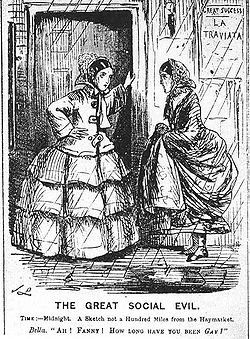 Cartoon from Punch magazine in 1857 illustrating the use of "gay" as a euphemism for being a prostitute. One woman says to the other (who looks glum), "How long have you been gay?" The poster on the wall is for La Traviata, an opera about a courtesan.
Cartoon from Punch magazine in 1857 illustrating the use of "gay" as a euphemism for being a prostitute. One woman says to the other (who looks glum), "How long have you been gay?" The poster on the wall is for La Traviata, an opera about a courtesan.
The word "gay" arrived in English during the 12th century from Old French gai, most likely deriving ultimately from a Germanic source.[1]
For most of its life in English, the word's primary meaning was "joyful", "carefree", "bright and showy", and the word was very commonly used with this meaning in speech and literature. For example, the optimistic 1890s are still often referred to as the Gay Nineties. The title of the 1938 French ballet Gaîté Parisienne ("Parisian Gaiety"), which became the 1941 Warner Brothers movie, The Gay Parisian,[6] also illustrates this connotation. It was apparently not until the 20th century that the word began to be used to mean specifically "homosexual", although it had earlier acquired sexual connotations.[1]
The derived abstract noun gaiety remains largely free of sexual connotations, and has, in the past, been used in the names of places of entertainment; for example W.B. Yeats heard Oscar Wilde lecture at the Gaiety Theatre in Dublin.[7]
Sexualization
The word had started to acquire associations of immorality by 1637[1] and was used in the late 17th century with the meaning "addicted to pleasures and dissipations."[8] This was by extension from the primary meaning of "carefree": implying "uninhibited by moral constraints." A gay woman was a prostitute, a gay man a womanizer and a gay house a brothel.[1]
The use of gay to mean "homosexual" was in origin merely an extension of the word's sexualised connotation of "carefree and uninhibited", which implied a willingness to disregard conventional or respectable sexual mores. Such usage is documented as early as the 1920s, and there is evidence for it before the 20th century,[1] although it was initially more commonly used to imply heterosexually unconstrained lifestyles, as in the once-common phrase "gay Lothario",[9] or in the title of the book and film The Gay Falcon (1941), which concerns a womanizing detective whose first name is "Gay." Well into the mid 20th century a middle-aged bachelor could be described as "gay", indicating that he was unattached and therefore free, without any implication of homosexuality. This usage could apply to women too. The British comic strip Jane was first published in the 1930s and described the adventures of Jane Gay. Far from implying homosexuality, it referred to her free-wheeling lifestyle with plenty of boyfriends (while also punning on Lady Jane Grey).
A passage from Gertrude Stein's Miss Furr & Miss Skeene (1922) is possibly the first traceable published use of the word to refer to a homosexual relationship. According to Linda Wagner-Martin (Favored Strangers: Gertrude Stein and her Family (1995)) the portrait, "featured the sly repetition of the word gay, used with sexual intent for one of the first times in linguistic history," and Edmund Wilson (1951, quoted by James Mellow in Charmed Circle (1974)) agreed.[10] For example:
They were ...gay, they learned little things that are things in being gay, ... they were quite regularly gay.—Gertrude Stein, 1922Other usages at this date involve some of the same ambiguity as Coward's lyrics. Bringing Up Baby (1938) was the first film to use the word gay in apparent reference to homosexuality. In a scene where Cary Grant's clothes have been sent to the cleaners, he must wear a lady's feathery robe. When another character inquires about his clothes, he responds "Because I just went gay...all of a sudden!"[11] However, since this was a mainstream film at a time when the use of the word to refer to homosexuality would still be unfamiliar to most film-goers, the line can also be interpreted to mean "I just decided to do something frivolous." There is much debate about what Grant meant with the ad-lib (the line was not in the script). The word continued to be used with the dominant meaning of "carefree", as evidenced by the title of The Gay Divorcee (1934), a musical film about a heterosexual couple. It was originally to be called "The Gay Divorce" after the play on which it was based, but the Hays Office determined that while a divorcee may be gay, it would be unseemly to allow a divorce to appear so.
Shift to homosexual
By the mid-20th century, gay was well established in reference to hedonistic and uninhibited lifestyles[12] and its antonym straight, which had long had connotations of seriousness, respectability, and conventionality, had now acquired specific connotations of heterosexuality.[13] In the case of gay, other connotations of frivolousness and showiness in dress ("gay apparel") led to association with camp and effeminacy. This association no doubt helped the gradual narrowing in scope of the term towards its current dominant meaning, which was at first confined to subcultures. Gay was the preferred term since other terms, such as queer, were felt to be derogatory.[14] Homosexual is perceived as excessively clinical,[15][16][17] since the sexual orientation now commonly referred to as "homosexuality" was at that time a mental illness diagnosis in the Diagnostic and Statistical Manual of Mental Disorders (DSM).
In mid-20th century Britain, where male homosexuality was illegal until the Sexual Offences Act 1967, to openly identify someone as homosexual was considered very offensive and an accusation of serious criminal activity. Additionally, none of the words describing any aspect of homosexuality were considered suitable for polite society. Consequently, a number of euphemisms were used to hint at suspected homosexuality. Examples include "sporty" girls and "artistic" boys,[18] all with the stress deliberately on the otherwise completely innocent adjective.
The sixties marked the transition in the predominant meaning of the word gay from that of "carefree" to the current "homosexual". By 1963, a new sense of the word gay was known well enough to be used by Albert Ellis in his book The Intelligent Woman's Guide to Man-Hunting. Similarly, Hubert Selby, Jr. in his 1964 novel Last Exit to Brooklyn, could write "[he] took pride in being a homosexual by feeling intellectually and esthetically superior to those (especially women) who weren't gay..."[19] Later examples of the original meaning of the word being used in popular culture include the theme song to the 1960–1966 animated TV series The Flintstones, whereby viewers are assured that they will "have a gay old time." Similarly, the 1966 Herman's Hermits song "No Milk Today", which became a Top 10 hit in the UK and a Top 40 hit in the U.S. and included the lyric "No milk today, it was not always so / The company was gay, we had turn night into day."[20] In June 1967, the headline of the review of the Beatles' Sgt. Pepper's Lonely Hearts Club Band album in the British daily newspaper The Times stated, "The Beatles revive hopes of progress in pop music with their gay new LP".[21] Yet in the same year, The Kinks recorded "David Watts".[22] Ostensibly about schoolboy envy, the song also operated as an in-joke, as related in Jon Savage's "The Kinks: The Official Biography", because the song took its name from a homosexual promoter they'd encountered who'd had romantic designs on songwriter Ray Davies' teenage brother; and the lines "he is so gay and fancy free" attest to the ambiguity of the word's meaning at that time, with the second meaning evident only for those in the know.[23] As late as 1970, the first episode of The Mary Tyler Moore Show has the demonstrably straight Mary Richards' downstairs neighbor, Phyllis, breezily declaiming that Mary is, at age 30, still "young and gay."
There is little doubt that the homosexual sense is a development of the word's traditional meaning, as described above. It has nevertheless been claimed that gay stands for "Good As You", but there is no evidence for this: it is a folk etymology backronym.[24]
Homosexuality
Sexual orientation, identity, behavior
The American Psychological Association states that sexual orientation "describes the pattern of sexual attraction, behavior and identity e.g. homosexual (aka gay, lesbian), bisexual and heterosexual (aka straight)". It says, "There is no consensus among scientists about the exact reasons that an individual develops a heterosexual, bisexual, gay, or lesbian orientation. Although much research has examined the possible genetic, hormonal, developmental, social, and cultural influences on sexual orientation, no findings have emerged that permit scientists to conclude that sexual orientation is determined by any particular factor or factors. Many think that nature and nurture both play complex roles."[25]
According to Rosario, Schrimshaw, Hunter, Braun (2006), "the development of a lesbian, gay, or bisexual (LGB) sexual identity is a complex and often difficult process. Unlike members of other minority groups (e.g., ethnic and racial minorities), most LGB individuals are not raised in a community of similar others from whom they learn about their identity and who reinforce and support that identity. Rather, LGB individuals are often raised in communities that are either ignorant of or openly hostile toward homosexuality."[26]
The British gay rights activist Peter Tatchell has argued that the term gay is merely a cultural expression which reflects the current status of homosexuality within a given society, and claiming that "Queer, gay, homosexual ... in the long view, they are all just temporary identities. One day, we will not need them at all."[27]
If a person engages in same-sex sexual encounters but does not self-identify as gay, terms such as 'closeted', 'discreet', or 'bi-curious' may be applied. Conversely, a person may identify as gay without engaging in homosexual sex. Possible choices include identifying as gay socially while choosing to be celibate or while anticipating a first homosexual experience. Further, a bisexual person can also identify as "gay" but others might consider gay and bisexual to be mutually exclusive. There are some who are drawn to the same-sex, and may not have sex, and also not identify as gay; these could have the term 'asexual' applied, even though an 'asexual' generally can mean no attraction, and includes heterosexual attraction that is not sufficient to engage in sex, or where the sex act is not desirable, even though titillation may occur.
Terminology
Some reject the term homosexual as an identity-label because they find it too clinical-sounding;[15][16][17] they believe it is too focused on physical acts rather than romance or attraction, or too reminiscent of the era when homosexuality was considered a mental illness. Conversely, some reject term gay as an identity-label because they perceive the cultural connotations to be undesirable or because of the negative connotations of the slang usage of the word.
Style guides, like the following from the Associated Press, call for gay over homosexual:
{{quote|Gay: Used to describe men and women attracted to the same sex, though lesbian is the more common term for women. Preferred over homosexual except in clinical contexts or references to sexual activity.[28]
Sociological theory
While the gay movement has been based on encouraging people to identify themselves as gay and "come out," there have been many who have argued that the approach is self-defeating. Among those are the advocates of labeling theory who argue that gay identity is a stigmatic role created by society to control and limit the behavior.
Strong defense of labeling theory also arose within the gay community. Many advocate dropping the label entirely. While adopted as a strategy for dealing with the oppression, gay identity comes with its own set of problems.
Gay community vs. LGBT community
Just as the word gay is sometimes used as a shorthand for the term LGBT, so is gay community sometimes a synonym for the LGBT community. In other cases, the speaker may be referring only to homosexual men. Starting in the mid-1980s in the United States, a conscious effort was underway within what was then called the gay community, to add the term lesbian to the name of all gay organizations that catered to both male and female homosexuals, and to use the terminology of gay and lesbian, or lesbian/gay when referring to that community. So, organizations like the National Gay Task Force became the National Lesbian/Gay Task Force. For many ardent feminist lesbians, it was also important that the L come first, lest an L following a G become another symbol of male dominance over women.[29] In the 1990s, this was followed by another equally concerted push to include the terminology specifically pointing out the inclusion of bisexuals and transgender people, reflecting an end to the intra-community debate as to whether these other sexual minorities were part of the same sexual liberation movement. Most news organizations have formally adopted this use, following the example and preference of the LGBT organizations, as reflected in their press releases and public communications. Today, many people interpret the phrase "gay community" to mean "the population of LGBT people."
Cultural relativity of the term
The concept of a "gay identity" and the use of the term gay itself may not be used or understood the same way in non-Westernised cultures since modes of sexuality may differ from those prevalent in the West.[30]
Descriptor
The term gay can also be used as an adjective to describe things related to homosexuals or things which are part of the said culture. For example, the term "gay bar" describes the bar which is either homosexually oriented, caters primarily to a homosexual clientele, or is otherwise part of homosexual culture.
Using it to describe an object, such as an item of clothing, suggests that it is particularly flamboyant, often on the verge of being gaudy and garish. This usage predates the association of the term with homosexuality, but has acquired different connotations since the modern usage developed.
Using the term gay as an adjective where the meaning is akin to "related to homosexual people, culture, or homosexuality in general" is a widely accepted use of the word.
People who oppose homosexuality, especially homophobic ones, may use the term gay in the pejorative sense, ascribing the term negative connotations.
Use as a noun
The label "gay" was originally used purely as an adjective ("he is a gay man" or "he is gay"). The term has been in use as a noun with the meaning "homosexual man" since the 1970s, as in "gays are opposed to that policy." Although some dislike this usage, it is common, such as in the case of "LGBT" ("lesbian, gay, bisexual, and transgender"), and particularly in the names of various organizations such as Parents, Families and Friends of Lesbians and Gays (PFLAG) and Children Of Lesbians And Gays Everywhere (COLAGE). It is sometimes used as a singular noun, as in "he is a gay", such as in its use to comic effect by the Little Britain character Dafydd Thomas.
Generalized pejorative use
When used with a derisive attitude (e.g. "that was so gay"), the word gay is pejorative. While retaining its other meanings, it has also acquired "a widespread current usage" amongst young people, as a general term of disparagement.[31][32] This pejorative usage has its origins in the late 1970s. Beginning in the 1980s and especially in the late 1990s, the usage as a generic insult became common among young people.[32]
This usage of the word has been criticized as homophobic. A 2006 BBC ruling by the Board of Governors over the use of the word in this context by Chris Moyles on his Radio 1 show, "I do not want that one, it's gay," advises "caution on its use" for this reason:
"The word ‘gay’, in addition to being used to mean ‘homosexual’ or ‘carefree’, was often now used to mean ‘lame’ or ‘rubbish’. This is a widespread current usage of the word amongst young people... The word 'gay' ... need not be offensive... or homophobic ... The governors said, however, that Moyles was simply keeping up with developments in English usage. ... The committee... was "familiar with hearing this word in this context." The governors believed that in describing a ring tone as 'gay', the DJ was conveying that he thought it was 'rubbish', rather than 'homosexual'. ... The panel acknowledged however that this use... in a derogatory sense... could cause offence in some listeners, and counselled caution on its use.The BBC's ruling was heavily criticised by the Minister for Children, Kevin Brennan, who stated in response that "the casual use of homophobic language by mainstream radio DJs" is:
"too often seen as harmless banter instead of the offensive insult that it really represents. ... To ignore this problem is to collude in it. The blind eye to casual name-calling, looking the other way because it is the easy option, is simply intolerable."Shortly after the Moyles incident a campaign against homophobia was launched in Britain under the slogan "homophobia is gay", playing on the double meaning of the word "gay" in youth culture.[34]
Parallels in other languages
The German equivalent for gay, schwul, which is etymologically derived from schwuel (hot, humid), also acquired the pejorative meaning within youth culture.[35]
The Spanish usually employ the term homosexual to describe gay people and the community. The Spanish slang terms for a gay male, maricon and joto, derive in the former case from the name Maria; in the latter, from associations with dances of similar names. The Spanish slang for a lesbian, manflor, appears to derive from an association with a "masculinized" flower.[36]
See also
- Anti-LGBT slogans
- Gender identity
- Gender identity disorder
- Gay bashing
- Hate speech
- Stigma
- Deviance (sociology)
- Labeling theory
- Heterosexism
- Human Rights Campaign
- LGBT rights opposition
- List of gay, lesbian or bisexual people
- LGBT themes in mythology
- National Gay and Lesbian Task Force
- Human male sexuality
- Religion and sexuality
- Sexuality and gender identity-based cultures
Notes
- ^ a b c d e f g "Online Etymology Dictionary". http://www.etymonline.com/index.php?term=gay.
- ^ "GLAAD: AP, New York Times & Washington Post Style". Archived from the original on 2008-01-08. http://web.archive.org/web/20080108082355/http://www.glaad.org/media/guide/style.php.
- ^ "APA Style Guide: Avoiding Heterosexual Bias in Language". http://www.apastyle.org/sexuality.html.
- ^ Sherwin, Adam (6 June 2006). "BBC ruling on use of the word gay". The Times (London). http://entertainment.timesonline.co.uk/tol/arts_and_entertainment/article671972.ece. Retrieved 3 May 2010.
- ^ "Anti-gay abuse seen to pervade U.S. schools". Archived from the original on 2007-03-01. http://web.archive.org/web/20070301145035/http://www.gay.com/news/article.html?2006/04/26/1.
- ^ The Gay Parisian (1941) - IMDb
- ^ "Publications". Oscar Wilde Society. 1 November 2008. http://www.oscarwildesociety.co.uk/publications.html. Retrieved 4 August 2009.
- ^ Oxford English Dictionary, entry for Gay.
- ^ "Bartleby dictionary". http://www.bartleby.com/81/10549.html.
- ^ Martha E. Stone, Sept–Oct, 2002. "Who were Miss Furr and Miss Skeene?", The Gay & Lesbian Review Worldwide.
- ^ "Bringing Up Baby". http://xroads.virginia.edu/~UG03/comedy/bringingupbaby.html.
- ^ "Oxford English Dictionary". http://www.oed.com/viewdictionaryentry/Entry/77207.
- ^ "Online Etymology Dictionary". http://www.etymonline.com/index.php?term=straight.
- ^ "A queer use of an inoffensive little word; Philip Howard". The Times: p. 12. June 7, 1976.
- ^ a b "Gay Adjectives vs. Lesbian Nouns". The New Gay. 16 September 2008. http://thenewgay.net/2008/09/gay-adjectives-vs-lesbian-nouns.html. Retrieved 4 August 2009.
- ^ a b James Martin (November 4, 2000). "The Church and the Homosexual Priest". America The National Catholic Weekly Magazine. http://www.americamagazine.org/content/article.cfm?article_id=2297. Retrieved 4 August 2009.
- ^ a b "AIDS and Gay Catholic Priests: Implications of the Kansas City Star Report". http://74.125.95.132/search?q=cache:w9cbQ6FTvXMJ:www.usc.edu/schools/annenberg/asc/projects/soin/enhancingCurricula/J468%2520STDT-%2520KC%2520STAR.pdf+homosexuality+%22overly+clinical%22&cd=2&hl=en&ct=clnk&gl=us&client=firefox-a.
- ^ Cocks, H. A. "'Sporty' Girls and 'Artistic' Boys: Friendship, Illicit Sex, and the British 'Companionship' Advertisement, 1913–1928", Journal of the History of Sexuality – Volume 11, Number 3, July 2002, pp. 457–482.
- ^ Selby, Jr., Hubert "Last Exit To Brooklyn" NY: Grove Press, 1988 p. 23 copyright 1964
- ^ "The Lyrics Library – Herman's Hermits – No Milk Today". http://www.mathematik.uni-ulm.de/paul/lyrics/hermanshermits/nomilk~1.html.
- ^ "The Beatles revive hopes of progress in pop music with their gay new LP". The Times (London). 2 June 2007. http://entertainment.timesonline.co.uk/tol/arts_and_entertainment/music/article1873296.ece. Retrieved 3 May 2010.
- ^ Kinks Song List
- ^ Savage, Jon "The Kinks: The Official Biography" London: Faber and Faber, 1984 pp.94-96
- ^ "Global Oneness Encyclopedia: Gay". http://www.experiencefestival.com/a/Gay_-_Etymology/id/1419120.[unreliable source?]
- ^ APA - What causes a person to have a particular sexual orientation?
- ^ Rosario, M., Schrimshaw, E., Hunter, J., & Braun, L. (2006, February). Sexual identity development among lesbian, gay, and bisexual youths: Consistency and change over time. Journal of Sex Research, 43(1), 46–58. Retrieved April 4, 2009, from PsycINFO database.
- ^ Tatchell, Peter (27 November 2006). "Just a phase". London: Guardian Unlimited. http://www.guardian.co.uk/commentisfree/2006/nov/27/isgayjustaphase. Retrieved 3 May 2010.
- ^ "GLAAD Media Reference Guide". http://www.glaad.org/files/MediaReferenceGuide2010.pdf.
- ^ Lesbian Ethics, pp. 13–21.
- ^ Masculinity for boys: A guide for peer educators; Published by UNESCO, New Delhi, Page: 102, Page: 62
- ^ a b Sherwin, Adam (6 June 2006). "Gay means rubbish, says BBC". London: Times newspaper online. http://entertainment.timesonline.co.uk/tol/arts_and_entertainment/article671972.ece. Retrieved 3 May 2010.
- ^ a b Denise Winterman (18 March 2008). "How 'gay' became children's insult of choice". BBC News. http://news.bbc.co.uk/1/hi/magazine/7289390.stm. Retrieved 26 May 2008.
- ^ "BBC's attitude to homophobic language 'damages children'". Pink News. http://www.pinknews.co.uk/news/articles/2005-4862.html. Retrieved 4 March 2009.
- ^ "Young Liberal Democrats launch 'homophobia is gay' campaign, Pink News, 2006". http://www.pinknews.co.uk/news/articles/2005-2607.html.
- ^ Robert Sedlaczek, Roberta Baron: leet & leiwand. Das Lexikon der Jugendsprache, Echomedia, 2006, ISBN 3-901761-49-7
- ^ Lloyd, Paul M. From Latin to Spanish: Historical Phonology and Morphology of the Spanish Language (Memoirs of the American Philosophical Society). American Philosophical Society, 1987.
Further reading
- Leap, William (1995). Beyond the Lavender Lexicon: Authenticity, Imagination, and Appropriation in Lesbian and Gay Language. Taylor & Francis. p. 360. ISBN 2884491813. http://books.google.com/books?id=loqEKRQQ68UC.
External links
- Gay at the Open Directory Project
Gender and sexual identities Gender identities Male · Female · Androgyne · Bigender · Boi · Cisgender · Genderqueer · Girlfags and guydykes · Intersex · Pangender · Transgender · WomynThird sex / Third gender Akava'ine · Eunuch · Fa'afafine · Fakaleiti · Femminiello · Hijra · Kathoey · Khanith · Mahu · Mukhannathun · Muxe · Bissu · Two-Spirit · HermaphroditeSexual orientation identities Ex-gay · Ex-ex-gay · Pansexual · Polyamorous · Banjee · Gay · Lesbian · Queer · Same gender loving · Non-heterosexual · Object sexuality · Kinsey scale · QuestioningSee also Sexual slang General Anilingus · Banjee · Bara · Bareback · Baseball metaphors for sex · Blue balls · Born-again virgin · Bottom (BDSM) · Camel toe · Circle jerk · Cock tease · Cunt · Deep-throating · Dirty Sanchez · Dogging · Donkey punch · Douche · Dyke · Fag hag · Felching · Fruit · Fuck · Gay-for-pay · Girlfriend experience · Glory hole · Hogging · Lipstick lesbian · Mama-san · Mammary intercourse · Mandarin Chinese profanity · Mile high club · Moose knuckle · Nookie · Pearl necklace · Pegging · Pussy · Queen · Quickie · Mat · Rusty trombone · Saddlebacking · Serosorting · Shemale · Slut · Snowballing · Soggy biscuit · Switch · Tea bag · Top · Top, bottom and versatile · Troll · Turkey slap · Voulez-vous coucher avec moi? · Wanker · Whale tail
LGBT-specific Bear · Beard · Bi-curious · Breeder · Bugchasing · Chicken · Chickenhawk · Chub · Daddy · Down-low · Party and play · Soft butch · Swish · Trade · Twink · U-Haul lesbian
In pornography Ass to mouth · Bukkake · Centerfold · Clothed female, naked male (CFNM) · Clothed male, naked female (CMNF) · Creampie · Cum shot · Deep-throating · Downblouse · Facial · Felching · Fluffer · Gang bang · Golden Age of Porn · Hardcore insert · MILF · Money shot · Paysite · Point-of-view · Stunt cock · Upskirt
Categories:- LGBT
- LGBT terms
- Sexual orientation
- Reclaimed words
Wikimedia Foundation. 2010.

